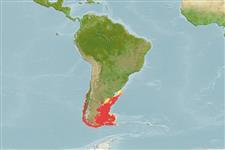| Native range | Point map | Year 2100 |

|
| Macruronus magellanicus AquaMaps Data sources: GBIF OBIS |
Issue
This species is synonym of Macruronus novaezelandiae (Hector, 1871) in Eschmeyer (CofF ver. Jan. 2012: Ref. 89336). Waiting for more confirmation. Please send references or more studies are needed.
Length at first maturity
Lm ?, range 54 - ? cm
Uso pelos humanos
Pescarias: altamente comercial
Phylogenetic diversity index
(Ref. 82805)
PD50 = 0.5625 many relatives (e.g. carps) 0.5 - 2.0 few relatives (e.g. lungfishes)
Nível Trófico
(Ref. 69278)
3.9 ±0.60 se; Based on food items.
Resiliência
(Ref. 69278)
Baixo, tempo mínimo de duplicação da população 4,5 - 14 anos (K=0.09-0.1)